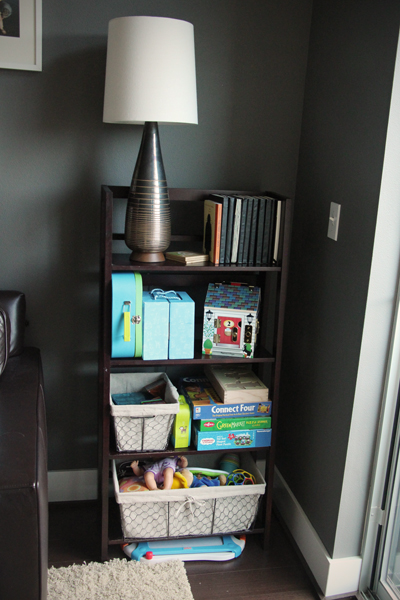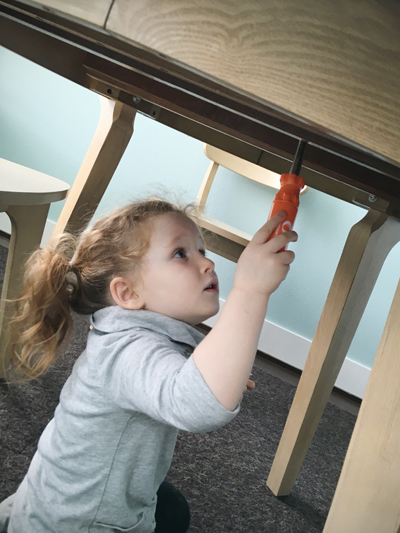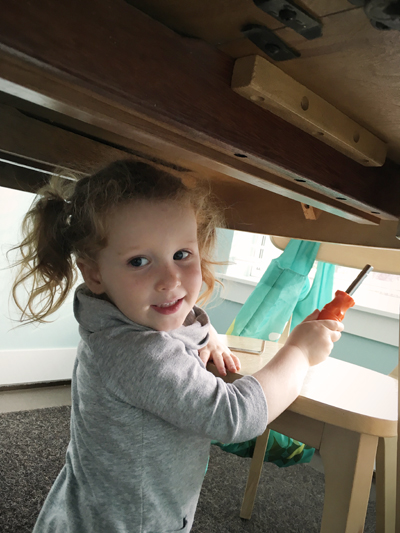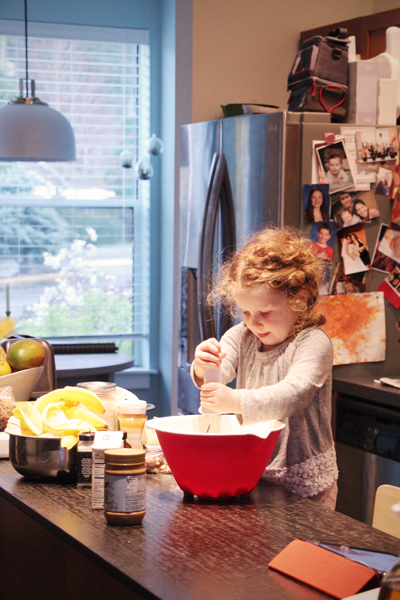Project Tidy continued last weekend with an emptying of our bathroom cupboards and our linen closet, followed by a go-through of Juliette’s toy collection.  There actually wasn’t a whole lot to discard from her toy shelf, but pulling everything out, putting all the stuffed animals and puzzles and matchbox cars into one big pile, was a good opportunity for me to stand back and consider my philosophy on playthings.  I read Simplicity Parenting last year and could only vaguely remember my favorite passages, so I took a second look at my highlights on Sunday and recommitted to a few main goals:
Don’t accumulate, don’t buy on a whim.
“To a child, a mountain of toys is more than something to trip over. Â It’s a topographical map of their emerging worldview. Â The mountain, casting a large symbolic shadow, means “I can choose this toy, or that, or this one way down here, or that: They are all mine! Â But there are so many that none of them have value. Â I must want something else!” Â This worldview shapes their emotional landscape as well; children given so very many choices learn to undervalue them all, and hold out – always – for whatever elusive thing isn’t offered. Â “More!” “
I love watching Juliette tear into gifts and get so much satisfaction from seeing her happily engage with a new toy.  But we’ve learned that her interest is fleeting, that she’d rather have a few precious playthings that allow her to imagine and pretend, like her MagnaTiles and her baby doll, than a mountain of “single-use” stuff.  It’s tempting to give in when she asks for that super-cuddly teddy bear from Costco or that cute wooden cash register from IKEA, but I’ve learned to stand my ground (and then treat her to a cookie instead!).  She gets toys for her birthday and on holidays, maybe an irresistible trinket or book every couple months, but other than that, “not right now, honey” is the party line.  If she does get something new, something old has gotta go – real estate is scarce on this toy shelf!
Keep it real.
“I think it is important that, whenever possible, what a child touches be real. Â A plastic hammer has no solidity, no weight or heft in the hands of a five-year-old. Â Even small versions of real tools are preferable to such blatantly false imitations…With such play comes the bonus of genuine involvement and mastery.”
Juliette is free to rummage in our tool drawer and our kitchen cupboards for playthings when her usual toys aren’t piquing her interest – cabinets and drawers that are off-limits are either locked or out of reach so that we don’t have to worry about her wielding knives or wine glasses.  She spent a solid 20 minutes under the dining room table with a screwdriver and a set of Allen wrenches a few weeks ago, shouting “I fix it, Mama!” as she tinkered away.  When I tell her I’m hungry, she’ll pull out a pot and a wooden spoon and throw together a batch of “spicy pepper soup†(main ingredients are puzzle pieces and spare change). I love watching her flex her imagination as she gives new meaning to the contents of our junk drawer. Letting her play with “real†things also goes a long way in helping me stick to objective #1, as I’m not buying a kid’s version of the stuff we already have on hand.
Let her “help”.
“Children love to be busy, and useful. Â They delight in seeing that there is a place for them in the hum of doing, making, and fixing that surrounds them…As small beings they can feel like inferior, passive observers of all that happens around them. Â A sense of industry – of busyness and purpose – counteracts feelings of overwhelm.”
I’ve mentioned before how much Jules loves helping me in the kitchen, and while her assistance usually doubles my cooking and clean-up time, I do my best to let her in on the action. Â I know she’s facing several years of being told she’s not old enough or big enough to do grown-up things, but she sure can stir with the best of them! Â Now if only she could scrub a toilet…



